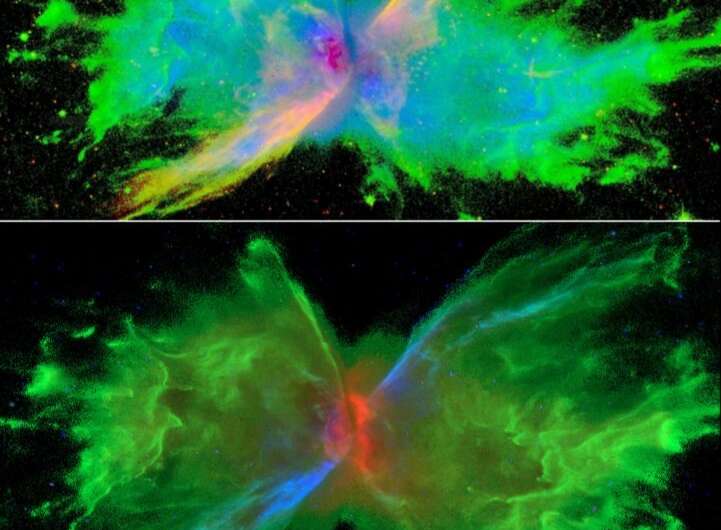Color overlay of WFC3 line ratio images of NGC 6302. Credit: Kastner et al., 2021.
Using the Hubble Space Telescope (HST), astronomers have conducted near-ultraviolet through near-infrared observations of a young planetary nebula (PN) known as NGC 6302. Results of the monitoring campaign, presented May 28 on arXiv.org, could help us better understand the nature of this PN.
PNe are expanding shells of gas and dust that have been ejected from a star during the process of its evolution from a main sequence star into a red giant or white dwarf. They are relatively rare, but are important for astronomers studying the chemical evolution of stars and galaxies.
Located some 3,400 light years away in the constellation Scorpius, NGC 6302 (also known as the Bug Nebula, Butterfly Nebula, or Caldwell 69) is a bi-lobed, pinched-waist PN rich in dust and molecular gas. Its relative proximity makes it a great target for high-resolution imaging aimed at understanding the origin and evolution of bipolar structures in the population of known PNe.
Therefore, a group of astronomers led by Joel H. Kastner of the Rochester Institute of Technology (RIT) employed Hubble's Wide Field Camera 3 (WFC3) in order to obtain comprehensive, contemporaneous sets of near-UV through near-IR (243 nm to 1.6 µm) emission-line images of NGC 6302.
"Here, we present the full suite of HST/WFC3 images of NGC 6302, along with various line ratio images and a detailed examination of the key results gleaned from these images thus far," the researchers wrote in the paper.
Hubble images show that NGC 6302 has a dusty toroidal equatorial structure that bisects the PN's polar lobes, and fine structures (like clumps, knots, and filaments) within the lobes. Such morphology is highly unusual for bipolar PNe, apart from certain multipolar PNe.
The study identified an unexpected bright, S-shaped 1.64 µm [Fe II] emission in NGC 6302 that traces the southern interior of the east lobe rim and the northern interior of the west lobe rim. The astronomers assume that this could be a zone of shocks caused by ongoing, fast, collimated winds from the PN's central star.
Furthermore, the research found that the object previously identified as the central star of NGC 6302 is in fact a foreground field star. The scientists added that a pair of bubble-like features in the core region of NGC 6302 likely indicates the central star's actual position within the PN's dusty central torus. However, more subarcsecond-resolution observations in the mid-IR and submillimeter wavebands are required to confirm this.
In concluding remarks, the authors of the paper noted that the results emphasize the mysterious nature of NGC 6302.
"The features revealed by our panchromatic HST/WFC3 images of NGC 6302—in particular, its distinct azimuthal structural zones and nested bubble system, and the surprising misalignment of the central engine's present collimated fast wind direction (as traced by 1.64 µm [Fe II] emission) and the nebula's main axis of symmetry (as defined by its dusty molecular torus, polar-axis clump system, and outer lobe walls)—presents an especially daunting challenge for models of the origin and evolution of bipolar structures in PNe," the scientists concluded.
More information: Panchromatic HST/WFC3 Imaging Studies of Young, Rapidly Evolving Planetary Nebulae. I. NGC 6302, arXiv:2105.13953 [astro-ph.SR] arxiv.org/abs/2105.13953
© 2021 Science X Network
























